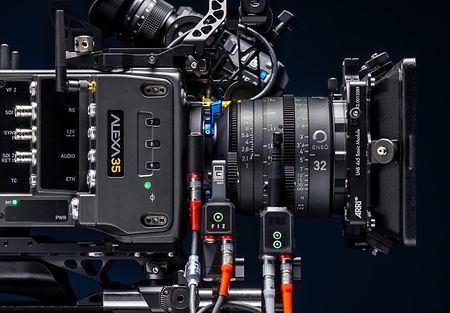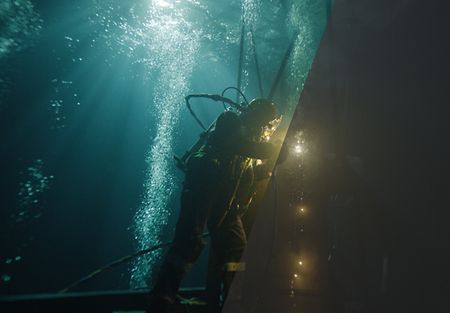Based on the original script by screenwriter Nergis Otluoğlu Akoğlu, the Turkish film “Kadinlara Mahsus” addresses violence against women through the story of eight women who come together on a retreat, each of them at a turning point in their lives. Celebrated director Serdar Akar was passionate about the project, tasking cinematographer Muko Tirmik with creating a look suitable for cinema release and HDR distribution. Tirmik set his sights on the new ALEXA 35 camera and acquired one of the first to arrive in Turkey; he also brought in seasoned colorist and visual consultant Andreas Brueckl, working with him from early preproduction to create a suitable color palette.
What guidance did the director provide for your visual approach on this film?
Muko Tirmik: When I first had a conversation with director Serdar Akar, he told me he wanted to make this movie for theaters, but also to create an HDR version for digital platforms. This was definitely a big challenge. The critical part was who the crew was going to be, who I was going to work with, and which camera I was going to use. I told the production team that I would like to work with the super-talented colorist Andreas Brueckl, who I had previously collaborated with in Abu Dhabi for a 13-episode HDR Netflix show. I had a clear idea of the camera I wanted to use, and we managed to get hold of the third ALEXA 35 to be delivered to Turkey.
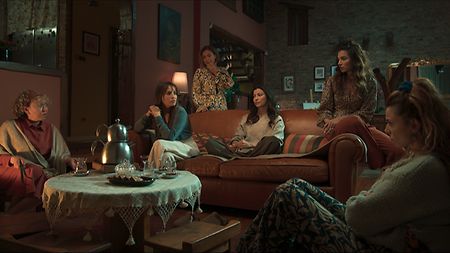
The ALEXA 35 excelled at low light scenes shot with practical light sources
Once Andreas was on board, what were the first stages of your work together?
Muko Tirmik: I had a great cooperation with Andreas right from the beginning. First, we chose the color palette, and with this color decision we included the costume, makeup, and art departments in our visual world. We did camera and lighting tests with our actual actresses and watched the results on an HDR screen and in a movie theater.
Andreas Brueckl: Color grading was only perhaps 40 percent of the work that I did on this show; the majority was in preproduction. We spent a lot of time planning color palettes and lighting design as a team. We would try things to see what worked and what didn’t, intensively developing the cinematography mood book and choosing costumes and wall colors accordingly. That kind of prep work is nothing new for big international productions where art teams work for a year on the design, but it’s fairly new for “smaller” productions, so I think it’s great for the Turkish industry that Muko took this approach to an HDR project.
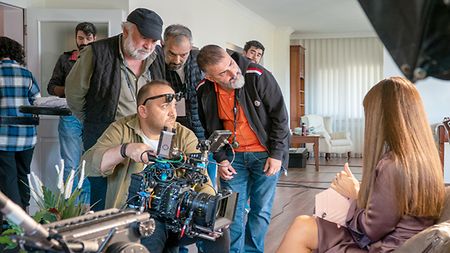
DP Muko Tirmik (center, with red shirt) and director Serdar Akar (left, in cap) on set with the ALEXA 35
Why did you want to use the ALEXA 35 on this film?
Muko Tirmik: I’ve worked with ARRI cameras since 1997: First with film cameras like the ARRIFLEX 535, 435 Xtreme, and 235, and then with every single ARRI digital camera. Each was the best camera of its era, but the ALEXA 35 feels like the biggest game changer. To me, a camera isn’t just a mechanical machine, it has a way of thinking. The ALEXA 35 made us feel safe with its amazingly helpful features. The other thing that made me feel comfortable was being able to use older Super 35 lenses. I was super stoked to choose Cooke S4 lenses for this project.
We were working with eight actresses and of course all the women had different skin tones and makeup, but the ALEXA 35 handled them all really well. With the right makeup from our experienced makeup artist, Sandra Ivatovic, as well as the right lighting and LogC4 from the camera, we saw great results. The colors were exactly how we wanted them, and the skin tones were protected nicely.

A lot of prep work was put into planning color palettes for the film
Did you develop LUTs, and was Andreas involved in dailies and on-set grading?
Andreas Brueckl: Our concept was a bit different, almost the opposite of on-set grading. The show LUT was created on the first day of the shoot according to the look that we agreed on in the mood book and the lighting situation on set. It makes a huge difference to create a LUT on set with the real conditions, rather than doing it in the grading suite beforehand. The look at this point should be maybe 75 percent final. So, Muko was lighting according to the LUT. In other words, if it didn’t look right, he changed his light until he basically saw the final image. This is a very detailed way of working.
In addition, during the first days of the shoot I was grading stills from the raw footage of some critical shots from the DIT and testing my grading suite. This was not about the dynamic range, but more about the contrast ratios. I was basically Muko’s second pair of eyes, on remote.

With eight actresses playing the main parts, the ALEXA 35’s accurate and pleasing rendition of different skin tones was an important factor
How does having an HDR deliverable affect the work that you do?
Muko Tirmik: Again, the ALEXA 35 is a huge help for HDR. The data integrity and the 17 stops of dynamic range gave us fantastic results. With the help of some specific HDR shooting techniques and 3D lighting setups, I was able to retain detail in all the highlights and all the shadows. We had a lot of low-light scenes, and the camera performed amazingly well. No detail was lost in the blacks, and it definitely made my job easier, helping me to make brave decisions while setting up the lighting, layer by layer. For HDR projects, the LogC4 tonal curve makes a huge difference; the highlights, low lights, mid-tones, and color saturation were even better than we needed!
Andreas Brueckl: If I know that a project has an HDR deliverable then I will actually grade for HDR first and then take the other versions from there, even if the first deliverable is P3 DCI. Because HDR has a wider dynamic range and greater color bit depth, I can grade super fine, which is then also reflected in the SDR versions. On this film we graded for HDR, DCI P3, and Rec 709, and the final grade was finished in just seven days, working six hours per day. The guys at the post facility didn’t understand how this was possible, but it was because of the work we’d done in prep.
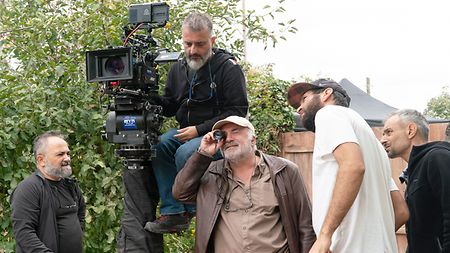
Director Serdar Akar checks his viewfinder, while cinematographer Muko Tirmik sits behind the ALEXA 35 camera
Muko, what were the 3D lighting setups you mentioned?
Muko Tirmik: The 3D lighting setups involve a very complicated technique. You need at least seven or eight layers of lighting, each with a different T-stop value, but no more than three stops between the highest and lowest values. These are some of my own rules that I came up with based on my experiences, giving me great HDR results every time. It requires being able to use a spot meter really well.
HDR is much closer to the two billion color values that human eyes can perceive, compared to SDR only reaching 1.7 million. Once you’ve graded for HDR in a coloring suite, or bought an HDR TV for your home, your eyes don’t want to look at SDR screens anymore. The ALEXA 35 helped me judge my lighting from the HDR screen.
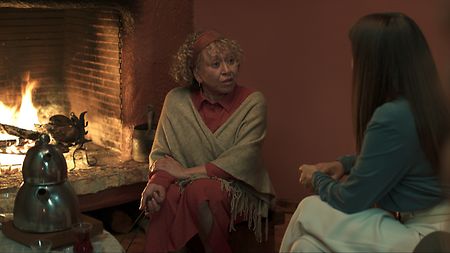
The ALEXA 35 is capable of retaining color in strong highlights while also capturing detail in shadow areas
Do you each have a scene in the film that you most enjoyed working on?
Andreas Brueckl: Definitely the day scenes in the villa. Those scenes put a lot of pressure on Muko as he was worried that the director might not give him enough time to light the set, because he’s known for shooting fast and changing angles. Muko didn’t want to compromise on the mood, so he had to be prepared for rapid changes. We tested some lighting setups and came up with the solution of painting the orange walls a darker magenta to minimize bounce, then creating layers with a lot of negative fill and practicals. The huge advantage with the ALEXA 35 was that Muko could bring in enough key light from the windows while still maintaining highlight details.
Muko Tirmik: There was a long and dramatic night scene with six women around a fire in the forest. If the lighting had looked exaggerated or fake, it would have killed the drama in the scene. Shooting in total dark would have meant difficult strong shadows, so we ended up doing day for night, waiting for the sun to set over the mountain and using the LUT in the camera. We started shooting when the shadows disappeared. The colors were fantastic and LogC4 gave us all the details for HDR, without disrupting the concentration of the actors.
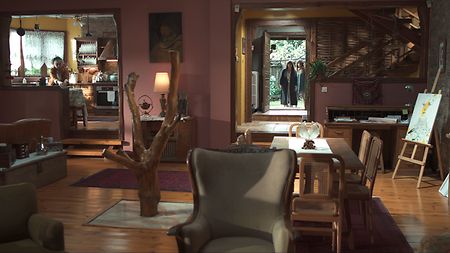
DP Muko Tirmik and colorist Andreas Brueckl worked closely with other departments to make sure that sets and costumes complemented their color palettes

